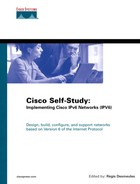Review Questions
Answer the following questions, and then refer to Appendix B, “Answers to Review Questions,” for the answers.
| 1: | List the three classes of integration and coexistence strategies presented in this chapter. |
| 2: | Describe the dual-stack approach. |
| 3: | What type of Ethernet frame is made by IPv6-only applications on nodes? |
| 4: | How do IPv4- and IPv6-enabled applications choose the IP stack when both IPv6 and IPv4 stacks are available? |
| 5: | Which type of address is preferred by IPv4- and IPv6-enabled applications when the naming service provides both IPv4 (A-record) and IPv6 (AAAA-record) address types? |
| 6: | When should you consider using integration and coexistence mechanisms? |
| 7: | What is the protocol number defined for the encapsulation of IPv6 packets in IPv4? |
| 8: | List the three scenarios presented in this chapter in which the tunneling of IPv6 packets in IPv4 is possible. |
| 9: | What is the main requirement of tunneling? |
| 10: | List all the tunneling techniques presented in this chapter. |
| 11: | What is the main characteristic of a configured tunnel? |
| 12: | What is the purpose of the tunnel broker and the tunnel server? |
| 13: | Describe how the prefix to a 6to4 site is assigned. |
| 14: | What is the purpose of the 6to4 relay? |
| 15: | Define the ISATAP address format. |
| 16: | Describe how the ISATAP unicast prefix is advertised to the ISATAP host by an ISATAP router. |
| 17: | Does the IPv4-compatible tunnel mechanism provide a solution to the IPv4 address space exhaustion? |
| 18: | List the two methods that allow IPv6-only nodes in an IPv6-only network to communicate with IPv4-only nodes in an IPv4-only network. |
| 19: | List the different types of operations defined for the NAT-PT mechanism. |
| 20: | What is the purpose of the 96-bit prefix for the NAT-PT mechanism? |
..................Content has been hidden....................
You can't read the all page of ebook, please click here login for view all page.
